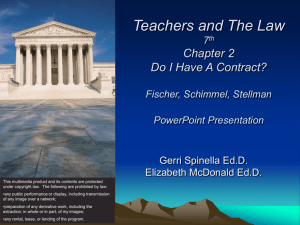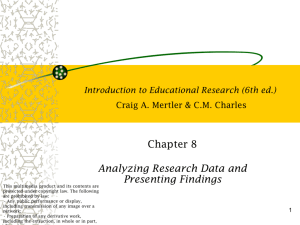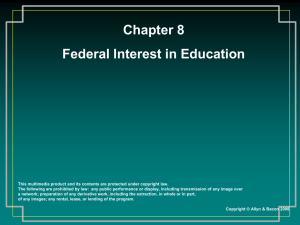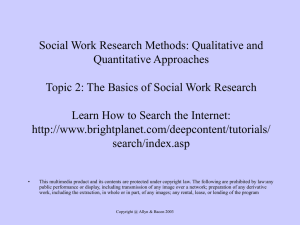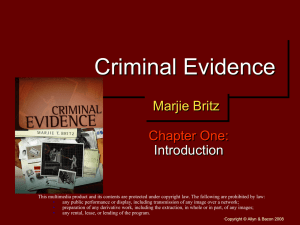chapt9
advertisement
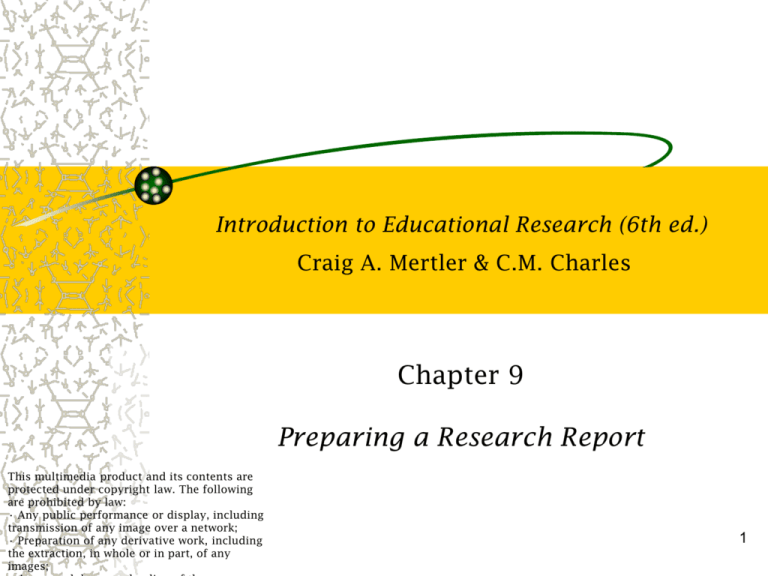
Introduction to Educational Research (6th ed.) Craig A. Mertler & C.M. Charles Chapter 9 Preparing a Research Report This multimedia product and its contents are protected under copyright law. The following are prohibited by law: • Any public performance or display, including transmission of any image over a network; • Preparation of any derivative work, including the extraction, in whole or in part, of any images; 1 Conventions in Research and Reporting • Conventions—agreed-upon procedures that help ensure accuracy, validity, credibility, etc. of a research study • Conventions of style: » Title—should indicate clearly what report is about; limit to approximately 15 words or less » Person and voice—typically written in third person and in passive voice » Tense—generally speaking, final reports written in past tense; proposals written in future tense 2 Copyright © Allyn & Bacon 2008 Conventions in Research and Reporting (cont’d.) » Tentative versus definitive statements—conclusions usually reported with tentative statements; procedures and results of descriptive analyses can be stated more definitively » Simplicity of language—use plain, straightforward language; don’t try to impress your readers…let your research speak for itself! » Consistency—consistency throughout the report is essential 3 Copyright © Allyn & Bacon Conventions in Research and Reporting (cont’d.) • Conventions of format: » Major sections of reports—not always labeled as such, but report is easier to follow if they are ◊ Introduction (Ch. 1 of thesis/ dissertation)— includes statement of problem, questions/hypotheses, limitations/delimitations, assumptions ◊ Review of related literature (Ch. 2) —organized from general to specific, older to more recent; use research questions/hypotheses to guide structure; end with a brief summary of the review 4 Copyright © Allyn & Bacon Conventions in Research and Reporting (cont’d.) ◊ Methods (Ch. 3)—includes description of participants and how they were selected, description of instrumentation, (including validity and reliability), data collection procedures, proposed methods of data analysis ◊ Findings or results (Ch. 4)—summarization of new information discovered through analysis of the data; may include tables and graphs; often organized by research question/hypothesis ◊ Conclusions or discussion (Ch. 5)—presents conclusions, implications, recommendations resulting from interpretation of the findings; only section where inclusion of researcher’s own thoughts are appropriate 5 Copyright © Allyn & Bacon Conventions in Research and Reporting (cont’d.) ◊ Front material—includes title page, signature page, acknowledgment page, dedication page, table of contents, list of tables and figures, and abstract ◊ Back material—includes references and appendices 6 Copyright © Allyn & Bacon Format of Thesis/Dissertations versus Journal Articles • Major differences with respect to: » Length of paper » Inclusion of front and back material 7 Copyright © Allyn & Bacon Style Guides • Many are available, including the two most commonly used: » Publication Manual of the American Psychological Association (5th ed.)…“APA Manual” * » The Chicago Manual of Style: The Essential Guide for Authors, Editors, and Publishers (14th ed.) 8 Copyright © Allyn & Bacon Applying Technology… Web sites & software to help write research reports • APA-Style Helper 5.0 (www.apastyle.org/stylehelper/ver5) • *** Take Note! *** 9 Copyright © Allyn & Bacon





